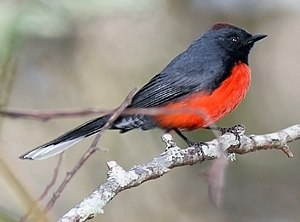Larval Wood Warbler
| Larval Wood Warbler | ||||||||||||
|---|---|---|---|---|---|---|---|---|---|---|---|---|

Larval Warbler ( Myioborus miniatus ) |
||||||||||||
| Systematics | ||||||||||||
|
||||||||||||
| Scientific name | ||||||||||||
| Myioborus miniatus | ||||||||||||
| ( Swainson , 1827) |
The larval wood warbler ( Myioborus miniatus ) is a small songbird from the genus Myioborus in the wood warbler family (Parulidae). It is the most common species of the genus. The distribution area extends from southwestern North America through Central America to South America . The IUCN lists them as “not at risk” (least concern).
features
Larval warblers reach a body length of 13 to 13.5 centimeters and weigh around 9.5 grams. The wing length is 5.8 to 6.7 centimeters in the male, 5.8 to 6.5 centimeters in the female. Adult male larval warblers of the nominate form have slate-gray head and upper plumage. The crown spot is yellow-brown-reddish and the front face, throat, beak and legs are blackish. The wings are blackish with slate-gray feather edges. As with all species from the genus Myioborus, the outer, white tail feathers are characteristic; the remaining tail feathers are blackish. The black coverts with the wide, white tips look like a cross-banded lattice. The underside plumage is vermilion.
Adult females are similar to the male. The subspecies hardly differ from each other except in the underside plumage. The subspecies Myioborus m. hellmayri a salmon-red-orange underside plumage, the subspecies Myioborus m. comptus an orange-yellow and the subspecies Myioborus m. ballux a yellow with an orange tinted chest plumage.
Juveniles of the nominate form have soot-gray head and upper plumage and a striped cinnamon-brownish lower plumage.
Occurrence, nutrition and reproduction
Larval warblers are mostly resident birds and only migrate to a limited extent within the altitude of the locations they inhabit. The northern subspecies also migrate to southeastern Arizona and southwestern New Mexico . In Mexico and in the north of Central America they inhabit moist, mountainous pine and pine - oak forests as well as cloud and cloud forests mostly at altitudes of 1500 to 3000 meters. In Costa Rica they can be found in submontane and montane forests at altitudes of 700 to 2000 meters, occasionally up to an altitude of 3000 meters. In South America they occur in submontane and montane forests in the Andes and in the tepuis of Venezuela , Guyana and Brazil at altitudes of 500 to 2500 meters. When encountering the closely related spectacle warbler ( Myioborus melanocephalus ), larval warbler show aggressive behavior. They mainly feed on insects and other invertebrates .
They build their bowl-shaped nest, built from moss , in the lower areas of the vegetation or on the ground as well as on sloping steep banks. A clutch usually consists of two to three eggs. The breeding season differs depending on the location: in Costa Rica from April to May and in Colombia from December to July. There are no precise studies of other breeding seasons. Fledglings that had just fledged were spotted in Chimborazo (Ecuador) in February, in Mérida (Venezuela) in August and in Junín (Peru) in December . The incubation period is 13 to 15 days. The young birds fledge after 12 to 14 days.
Subspecies and distribution
There are twelve recognized subspecies:
- Myioborus m. miniatus ( Swainson , 1827) - highlands in Mexico ( Sonora , Chihuahua , San Luis Potosí , Guerrero , Oaxaca and Chiapas )
- Myioborus m. molochinus Wetmore , 1942 - Sierra de los Tuxtlas in southeastern Veracruz
- Myioborus m. intermedius ( Hartlaub , 1852) - southern Mexico (Oaxaca, Chiapas) and northern Guatemala
- Myioborus m. verticalis ( d'Orbigny & Lafresnaye , 1837) - southern Ecuador, central Bolivia and on the tepuis in southern Venezuela, northern Brazil and northern Guyana
- Myioborus m. aurantiacus ( SF Baird , 1865) - eastern Costa Rica and western Panama
- Myioborus m. ballux Wetmore & Phelps , 1944 - southeastern Panama, northern Colombia, western Venezuela to northern Ecuador
- Myioborus m. comptus Wetmore, 1944 - western and central Costa Rica
- Myioborus m. connectens Dickey & van Rossem , 1928 - El Salvador and Honduras
- Myioborus m. hellmayri Van Rossem, 1936 - southern Guatemala to southwestern El Salvador
- Myioborus m. pallidiventris ( Chapman , 1899) - northern Venezuela
- Myioborus m. sanctaemartae room , 1949 - northern Colombia
- Myioborus m. subsimilis room, 1949 - southwest Ecuador and northwest Peru
swell
literature
- Jon Curson, David Quinn, David Beadle: New World Warblers. Helm, London 1994, ISBN 0-7136-3932-6 .
Web links
- Myioborus miniatus in the endangered Red List species the IUCN 2008. Posted by: BirdLife International, 2008. Accessed on 7 February, 2009.
- Larval Warbler at ITIS
